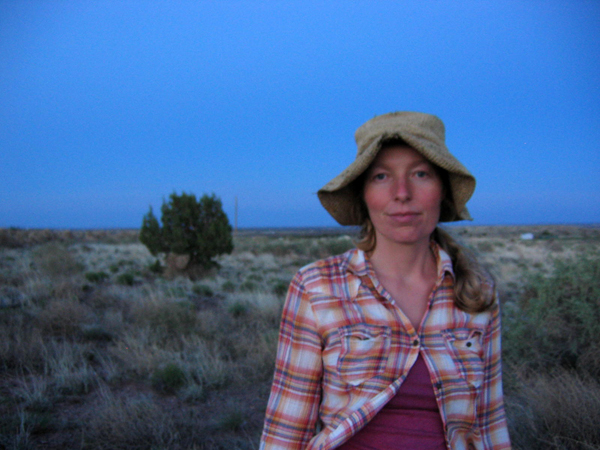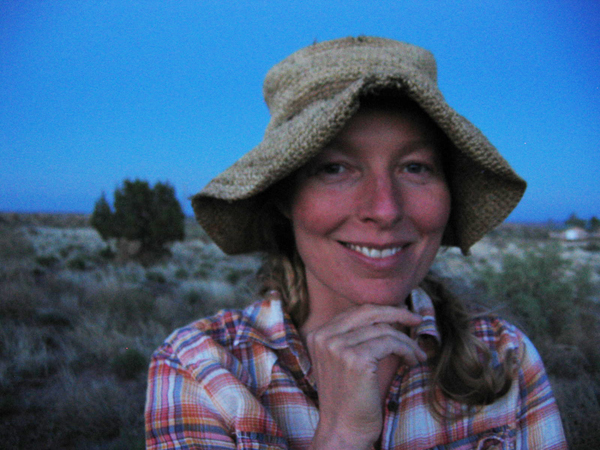Thilde Jensen’s recovery from environmental illness
by Julie Genser

Thilde Jensen visits the chemically and electrically sensitive
community in Snowflake, Arizona. © Julie Genser
Thilde Jensen is an extremely likable 39-year-old Danish woman. Her broad cheekbones and piercing blue eyes hold your attention easily. Soft-spoken but not shy, she’s the kind of person that enters effortlessly into engaging conversation with just about anyone, and makes you feel listened to; heard. She cries easily when you share of your pain or past trauma. It’s this compassionate nature and ability to converse with just about anyone that makes her such a good photojournalist. And those were the conditions I met her under; as a photojournalist traveling across country to document how people with severe chemical and electrical sensitivities are living. She was only able to make the trip because she recovered 80% of her health after suffering from severe chemical and electrical sensitivities herself for the past eight years. And it only took a couple days of Annie Hopper’s Dynamic Neural Retraining System™ (DNRS™) workshop for her to experience a big shift that would completely turn her life around. This is her story.
Born in Denmark in the early ’70s, Thilde had a fairly “normal” childhood. She came to New York City to study photography at the School of Visual Arts when she was 25. For work, she printed in the darkroom for other photographers and did some editorial work for prestigious magazines such as Newsweek and Details.
And then 9/11 happened.
At the time, Thilde was living in Brooklyn with her husband, right next to the Brooklyn Queens Expressway (BQE). Dump trucks spewing black exhaust would sit idling right outside her apartment. She began having chronic sinus and ear infections, which led her to quit her job and start juicing, eating healthier and living a generally healthier, less stressful lifestyle. It worked; she started to feel healthy again. So she went back to working in the darkroom. But work was slow and after 9/11 it became more and more difficult to find work. The stress of not working coupled with the stress of 9/11 took its toll.
About a year after 9/11, the apartment below hers was renovated. They lacquered the floor without ventilating. Thilde woke up feeling drunk and felt that way for the next month without relief. She started having problems being around car exhaust. Like others on the fast road to severe chemical sensitivity, she tried alternative treatments to try to manage her increasing symptoms. After doing acupuncture sessions three times a week for a month or two she was able to be around traffic again.
Then the Iraq War started, which was very traumatic for her. She started sensitizing to everything in her environment. First it was car exhaust and books. Then cigarette smoke and perfume.
She decided to move to Syracuse, NY to study Environmental Science. It meant living separate from her husband, who had to remain in NYC for work. But they were willing to work through the challenges. Somehow Thilde managed to begin the program and take classes, even with all the environmental sensitivities she was developing. Then, ignorant to the dangers of pesticide, she applied a flea killer to her cats and ended up losing everything. She had to send her cats back to her husband in NYC. Things got so bad, at times she was catatonic, unable to care for herself. She realized that she would have to return to Denmark in order to apply for disability benefits.

Thilde at dusk. © Julie Genser
Her diagnosing physician in Denmark told her she had the worst case of environmental illness he had ever seen. She returned to America, moving to Tucson to survive through the winter. Her marriage had fallen apart and she had become electrically sensitive and could no longer drive a car, be on the phone, watch T.V., or use the computer.
Thilde lived in Tucson for a while then returned to upstate New York to check out an ecovillage. She ended up moving there and still lives there today. Her community is spread out so each resident has a lot of space and privacy, and the members agreed to live fragrance free for her and a couple other chemically sensitive residents. She had a fairly comfortable life there, only wearing her big respirator mask when she had to interact with the public, like for shopping or to access health care.
Thilde lived in this ecovillage for five years before she heard about the DNRS™ workshop. An MCS friend of hers had read about Annie Hopper on Planet Thrive, and immediately called her to tell her about it. Thilde had heard about recoveries of people who had done faith-based Christian programs (such as Pastor Henry Wright’sBe In Health) and deducted that the illness must have something to do with the brain. So when she heard that Annie Hopper had used brain plasticity exercises to recover from her own chemical and electrical sensitivities, she knew this could be the answer for her. She participated in a workshop just 5 short weeks later, in September 2010, in Canada – only 6 hours from where she lives in NY.
Brain plasticity refers to the phenomenon of the brain constantly creating new neuronal “mind maps” in response to a daily stream of new experiences and sensory input. This means that throughout our lives, humans are capable of learning new things – such as new languages, how to play a new musical instrument, and even how to subconsciously react to perceived threats in our environment. With practice, our abilities increase as new neuronal pathways are further entrenched; the language becomes easier to speak and eventually becomes second habit, requiring very little conscious thought, we are able to play more difficult music – faster and with more accuracy. In this way, Annie Hopper uses neuro-linguistic programming (NLP) and a host of complementary modalities to reprogram the stress response and unconscious reactions of those with EI to environmental influences such as chemicals and EMFs, until we no longer need the exercises and our healthy responses to these outside influences becomes completely automatic and permanent. (For more on the program, please see dnrsystem.com and limbicretraining.com.)
Thilde loved Annie Hopper’s energetic presentation style. She fortunately was able to make an early connection back to a childhood memory that made her feel really safe and protected, and she used that in the visualization part of the program. After only the second day, she experienced a huge improvement in her symptoms. She had been camping outside the fragrant rooms and was wearing her mask at first. That was the last time she ever wore her mask. She was able to sleep in her room the next two nights without a problem. Her EMF sensitivity was also tremendously helped – now she can be on the computer for hours, after avoiding it for years.
Thilde shared that others in her workshop also experienced deep improvements in their symptom set and that it was a magical, life-changing experience. How will her life change now that she’s improved so dramatically? For starters, she is returning to her love of photojournalism and traveling around the country to photograph others challenged by environmental intolerance. Her plan is to publish a coffee table style photo book. The NY Times has already expressed interest in publishing an exclusive review of the book.
To hear more about Thilde’s recovery, listen to her testimonial for the DNRS™ program below:
No comments:
Post a Comment